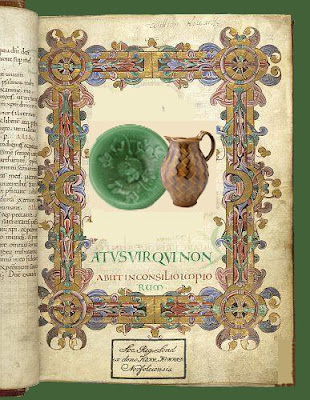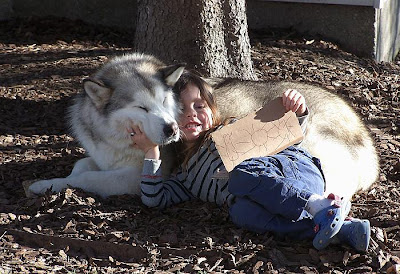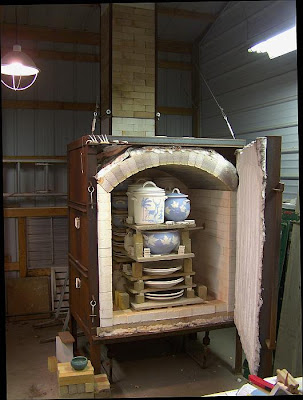A music analogy! A man after my own heart! And some of what you say is, no doubt, a good characterization of at least one perspective on the issue. And in this changing world (or, as Sir Paul so daftly put it, “in this ever-changing world in which we live in”) maybe you are absolutely right.
Maybe the art fairs need to grow up and understand that it is childish romanticism that makes a buying public care HOW an artwork is made – or that hand-work would be the biggest part of that equation.
Maybe art fairs – as a marketing concept – are passé. Maybe it’s time we started admitting that this whole romantic notion that there is any meaningful difference between a pot conceived and made by, say, Ellen Shankin or Jane Hamlyn (who just happen to be my favorite potters in the world), holds any inherent difference – much less superiority to a pot conceived by Ellen Shankin or Jane Hamlyn but produced in a Chinese factory.
After all, as art fair “artists” defending art fairs, we gave up our very raison d'être when we thought that the question was “What is art?”, when the question that mattered was “What is craft?”.
See, in my own musical analogy I see it more like this:
About fifty years ago a group of musicians noted that, as much as people LOVE to listen to recordings of music, or concerts held-eld-eld in-in-in-in stadium-um-um-ums, this group of musicians figured out that there was still a market for LIVE, intimate, small venue music. So they started a concert series on their own. The thing that was to set this concert series apart from the rest of the music world (apart from the music world of BIG, FAMOUS performers and recording contracts with major labels) was that the music was to always be produced live and on the spot – real instruments, real voices. Nothing pre-recorded. And they discovered that:
1. People liked the close personal contact with the musicians
2. Though some might say that in the final analysis, music is music – whether live or recorded – these small venue musicians noticed that people made a visceral connection to watching hands play a violin, or watching as a singer emoted, or hearing – from five feet away -- the extraneous squeak of fingers across a guitar string. To these people – these music patrons -- their recordings were NOT the same as watching live music, though, when they took recordings OF these small-venue, live musicians home with them, they enjoyed BOTH the recordings AND the memories of the live encounter that the recordings brought to mind.
3. That the people who dedicated themselves to the live, small venue performance of music had become excellent in their own right. They didn’t fill out the 10,000 seat music halls like the famous – not because their music was inferior, but because their life choices made them less interested in the mainstream music, and that disinterest in the mainstream ended up translating into a greater and more flexible creativity. Besides, in many cases this music, though excellent, just might have been too esoteric for the general music-buying, record store haunting, pop-music-buying teen. It wasn’t the stuff of mass-market
In other words; the small venue concert series was a resounding hit! People appreciated the difference. They appreciated the difference so much that they supported the small venue, live musician pretty darn well.
But along came digital sampling.
Some guy figured out that he could make a machine that would make the exact same sound as a guitar – right down to the finger squeaks on the strings. What’s more, he could play any song with his sampler. Unlike the live guitar player who had to actually learn a piece before he could play it, the guy with the synthesizer could play ANYTHING – even the technically very difficult pieces -- because he could play as slowly as was required to get notes in the right order – and then go back later and edit out the bad notes and speed the remaining notes to tempo. He could even add a drum track and a whole violin section behind him.
So the synthesizer guy started coming to the small venue concert hall and sitting in with the other musicians with his magic box full of the songs he’s put together. He can jam with them flawlessly. His arrangements are marvelous. Inspired, even. If people in the crowd ask “what’s he playing?” he answers “Music.” Because that is, after all, one accurate description of what he is playing. Music.
And when the crowd starts to shout out requests from the assembled live small venue, this music box player can play almost ANYTHING from his playlist (which dwarfs any other musician’s playlist – after all, the box guy doesn’t have to recall anything. He just looks down his list of pre-recorded stuff and viola! The song pops out, full arrangement).
And the dancers dance. And the sing-alongers karaoke themselves hoarse.
But eventually, the crowd that used to come to the small venue became divided. Some liked the box-player. His arrangements became their standard for how a song should be played.
But others, though they couldn’t explain why it mattered to them (because they didn’t know in the first place) missed SEEING the music. They missed the inherent mistakes and irregularities that seemed to charm them into loving the live music in the first place.
And the live musicians, for their part, were equally divided. Some kinda left in a huff, or asked the box player if he wouldn’t maybe consider playing quieter, or playing in fewer of the songs…something that would make the live musicians feel some reason for being there.
But the majority of the musicians felt as though, as long as the guy was playing music they should just shut up. Even if they personally were never heard from again – music was, after all (they thought) what we were all gathering for. Wasn’t it?

And so, I find it a curious coincidence that this photographer (with whom I was having the original discussion I’m recounting here) chose the music analogy that he did – that of recording media.
Curious, because photographers are the only art fair artists who are coming to the art fair with “recordings” only. …oh, I suppose that both printmakers and cast sculptors bring recordings too.
But in both those cases, the artists still hand-manipulate (<<--redundancy if ever was!) the medium that is later printed or cast.
Further… If my “small venue musician” analogy does not ring more true than the photographer’s musical allusion, then why do a MAJORITY of art fairs still ask if you (as a participating artist) are willing to demonstrate at the show? A sculptor or printmaker can demonstrate at a show. I see it all the time. I think that every other medium can demonstrate at a show. Has an art fair photographer ever checked the “Yes, I will demonstrate” box for an art fair? If so, what did this photographer demonstrate?
Art fairs are a “marketing angle”. They are a marketing angle to sell decorative art, of course…
...but then so are galleries. So are publications. So are department stores. So are auction houses. So is ebay. Nothing stops an artist from pursuing his art and selling it at any of the above places. MOST decorative art is sold in any of those multiple ways.
But the singular “marketing angle” that art fairs have successfully employed for decades is that the decorative arts offered therein are hand-crafted. And with that hand-craftedness comes the inference of value – a time honored inference – that that which is rarer is of greater value. Craftsmen cannot produce endless inventory.
Art fair patrons know that and value that.
We are NEVER going to not have photography at art fairs. And I, for one don’t even think that’s a good idea. The issue of whether they fit into the art fair scene is not “Is it art?” As a medium, it has proven to often be “art”. Good art, too. Fine art.
And photography can reflect craftsmanship too. Often does. So it always seems to come down to what a few brave but outnumbered photographers have suggested all along – that art fairs charge their juries MORE SPECIFICALLY to single out the craft/craftsmanship.
If method of production is immaterial (and photographers, almost to a man at the art fairs, say that it is) then the craftsmanship is implied in the subject matter.
So, if that is the case, then any photography that is merely the appropriation of another’s craft – the architecture of Europe, window casings and doorways, winding Shaker Staircases – should be suspect, no?
And nature itself is a sticky wicket if nothing is brought to it, right? After all, we are balancing the “artness” and the “craftness” and to merely shooting wildlife could likely be neither art nor craft, but “journalism”. Right? So perhaps finding a set of standards with which to charge future juries might be a healthy direction?
Enough for one day!


 The musical force of gravity has been strong around Jim's shop -- Wooden Music -- for years now. Most everyone in the surrounding counties of Indiana and Michigan know about Jim as a repair guy and builder. And if you happen to take in the sets of a few local bands, it's not unusual to see entire trios playing nothing but Jim Shenk's instruments (the locally famous "Goldmine Pickers" regularly have three of Jim's instruments on stage).
The musical force of gravity has been strong around Jim's shop -- Wooden Music -- for years now. Most everyone in the surrounding counties of Indiana and Michigan know about Jim as a repair guy and builder. And if you happen to take in the sets of a few local bands, it's not unusual to see entire trios playing nothing but Jim Shenk's instruments (the locally famous "Goldmine Pickers" regularly have three of Jim's instruments on stage).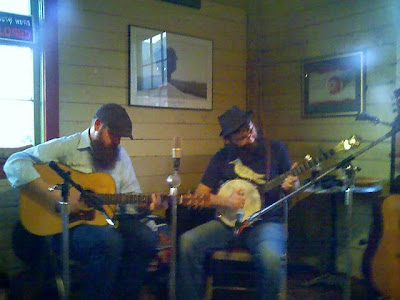

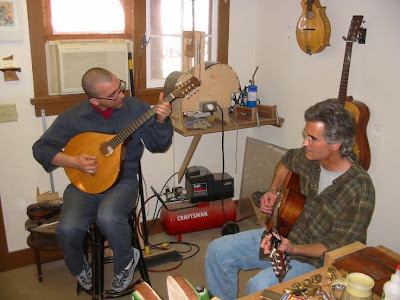
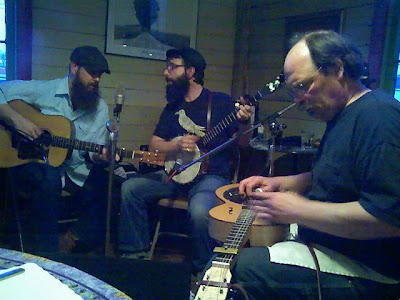 Jim's always been a darn good guitar player. He's had a band since he was a teenager. Same two guys he's gigged with regularly since then. When they want to, they can get pretty solid booked. They play a nice mix of music that has been carefully picked to sound familiar, yet fresh. Only band around I know who plays Notting Hillbillies stuff. Jim told me last night that the mandolin player of the three of them cut off all four fingers of his right hand on a table saw. Said they're all sewn back on, but learning to play with 'em has been pretty depressing.
Jim's always been a darn good guitar player. He's had a band since he was a teenager. Same two guys he's gigged with regularly since then. When they want to, they can get pretty solid booked. They play a nice mix of music that has been carefully picked to sound familiar, yet fresh. Only band around I know who plays Notting Hillbillies stuff. Jim told me last night that the mandolin player of the three of them cut off all four fingers of his right hand on a table saw. Said they're all sewn back on, but learning to play with 'em has been pretty depressing. 













